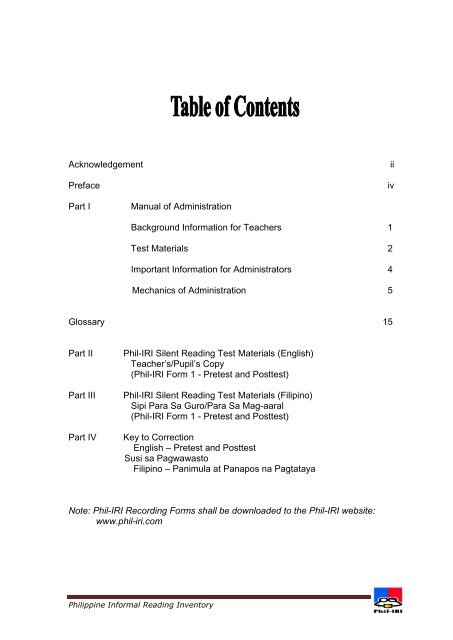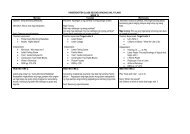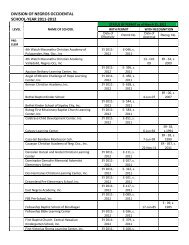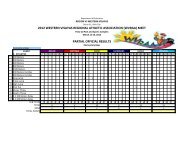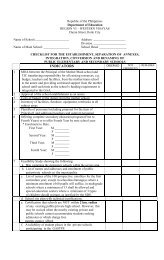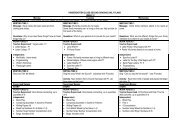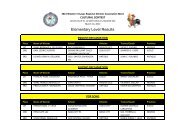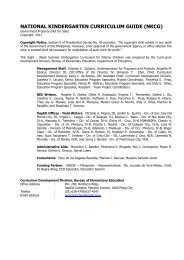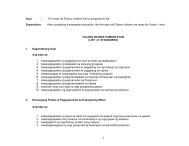manual (silent reading) - Department of Education Regional Office 6
manual (silent reading) - Department of Education Regional Office 6
manual (silent reading) - Department of Education Regional Office 6
Create successful ePaper yourself
Turn your PDF publications into a flip-book with our unique Google optimized e-Paper software.
ConsultantsEnglishMerry Ruth M. GutierrezFaculty, College <strong>of</strong> LanguagesLinguistics and LiteraturePhilippine Normal UniversityTaft Avenu, ManilaFilipinoAurea Jean A. AbadEditor, Dane PublishingMindanao Avenue, Quezon CityProject Management StaffYolanda S. QuijanoAngelita M. EsdiculFe M. VillalinoDirector IV, BEEDirector III, BEEChiefStaff Development Division, BEEProject Coordinators/Writers(English/Filipino)Jocelyn S. TuguinayoLigaya G. IlaganPaz Levita V. GalapirJaime B. BungaSr. <strong>Education</strong> Program Specialist<strong>Education</strong> Program Specialist II<strong>Education</strong> Program Specialist II<strong>Education</strong> Program Specialist IISupport StaffGlenda M. GranadozinGlotilde G. de GuzmanRommel LiwanagRonald RosalesAdministrative Asst. IAdministrative Aide IIIAdministrative Aide IAdministrative Aide IPhilippine Informal Reading Inventoryiii
PHILIPPINE INFORMAL READING INVENTORY (Phil-IRI)SILENT READING, SPEED AND COMPREHENSIONA. BACKGROUND INFORMATION FOR TEACHERS (BIT)The Informal Reading Inventory (IRI) is one <strong>of</strong> the most useful classroom toolsin assessing a pupil’s <strong>reading</strong> ability. It can give the teachers information on the level<strong>of</strong> their pupils’ performance in <strong>reading</strong> by actual observation. A typical IRI isadministered individually and consists <strong>of</strong> graded stories followed by comprehensionquestions <strong>of</strong> different dimensions. Depending on the purpose, an IRI may containcomprehension questions on a few or more <strong>of</strong> the following <strong>reading</strong> skills: getting themain idea, inferencing, sequencing events, finding cause-effect relationships, andnoting details. Most IRIs would include measures <strong>of</strong> word miscues andcomprehension as well as provision for pupil retelling <strong>of</strong> the passage read. Thus, theIRI provides the teachers with a comprehensive pr<strong>of</strong>ile <strong>of</strong> their pupils’ ability in<strong>reading</strong>, whether orally or <strong>silent</strong>ly, including their <strong>reading</strong> habits and attitudes. Theteachers may then use the information in planning their classroom <strong>reading</strong>instruction.The Philippine Informal Reading Inventory (Phil-IRI)-Silent Reading Test isone variation <strong>of</strong> IRI. It is adapted in the context <strong>of</strong> IRI to help teachers determine the<strong>reading</strong> abilities and needs <strong>of</strong> their pupils in order to provide bases for planning theirclassroom instruction.The Phil-IRI-Silent Reading Test is an informal measure that assesses thepupils’ <strong>reading</strong> speed and comprehension skills in <strong>silent</strong> <strong>reading</strong>. It consists <strong>of</strong>graded <strong>reading</strong> passages from Grade I to Grade VI. Each graded passage isfollowed by 7comprehension questions for Grades I-III and 8 comprehensionquestions for Grades IV-VI. The questions are categorized into three dimensionsnamely literal, interpretive and applied. The critical questions are subsumed in theapplied dimension. The definitions <strong>of</strong> each dimension can be found in the glossary <strong>of</strong>this <strong>manual</strong>.The passages may either be narrative or expository texts. They are carefullywritten to ensure that the characters, setting and plot appeal to the children. Theyare culture-neutral, gender-free and without biases against religion, ethnicity/raceand socio-economic status. They are also laden with values and real-life lessons.The Phil-IRI-Silent Reading Test gives quantitative information about thepupil’s <strong>silent</strong> <strong>reading</strong> capabilities. Quantitative information shows the <strong>reading</strong> levelsnamely: frustration, instructional and independent. Furthermore, it usespredetermined set <strong>of</strong> criteria in identifying the <strong>reading</strong> levels <strong>of</strong> the pupils such as the<strong>reading</strong> speed and percentage <strong>of</strong> correct answers to comprehension questions. Ithas adapted the combination <strong>of</strong> bands <strong>of</strong> <strong>reading</strong> rate (words per minute) proposedby Morris and Gunning.Philippine Informal Reading Inventory1
1. Manual <strong>of</strong> AdministrationThe <strong>manual</strong> includes the Background Information for the Teachers, themechanics for the administration <strong>of</strong> the test and instructions for recording andreporting results. It serves as a guide to teachers, principals and supervisorsin administering the tests as well as in recording results. The <strong>manual</strong> shouldbe studied carefully before administering the Phil-IRI-Silent Reading Test. Themechanics <strong>of</strong> administration are the same for both English and Filipino. Thus,only one <strong>manual</strong> will be printed for both English and Filipino.2. Teacher’s CopyThe teacher materials for the Phil-IRI- Silent Reading Test consist <strong>of</strong>the following forms: Phil-IRI Form 1: Grade Level Passage Rating Sheet - This is the ratingsheet which the teacher marks the comprehension score <strong>of</strong> the pupil as wellas the pupil records his/her <strong>reading</strong> time while taking the test. The ratingsheet contains the passage to be read <strong>silent</strong>ly by the pupil. This is followedby comprehension questions which the pupil will answer. The teachershould ensure that each pupil is provided with this form. Phil-IRI Form 2: Individual Summary Record - This form serves tosummarize the performance <strong>of</strong> each pupil. The teacher should transfer themarks <strong>of</strong> the pupil in the Phil-IRI Form 1 to his/her individual Phil-IRI Form 2. Phil-IRI Form 3: Class Reading Pr<strong>of</strong>ile – This form shows the class<strong>reading</strong> pr<strong>of</strong>ile. The teacher should fill this with the data from pupils’ Phil-IRIForm 2. He/she should submit this form to the principal/school head who willconsolidate all the class pr<strong>of</strong>iles to establish the school <strong>reading</strong> pr<strong>of</strong>ile.3. Pupil’s CopyThe same copy <strong>of</strong> the grade level passage rating sheet (Phil-IRI Form 1)which the teacher uses in marking the score <strong>of</strong> pupils will also be used by thepupils. The <strong>silent</strong> <strong>reading</strong> passages are either paragraphs, stories orpassages that the pupils read <strong>silent</strong>ly. Each paragraph/story/passage isfollowed by comprehension questions categorized as literal, interpretive andapplied.4. Other Phil-IRI Forms(to be downloaded at Phil-IRI website: www.phil-iri.com)Philippine Informal Reading Inventory3
D. MECHANICS OF ADMINISTRATIONImportant Notes:Before administering the Phil-IRI-Silent Reading Test, the teacher shouldnote the dates <strong>of</strong> administration for both pretest and posttest. The teacher should atall times keep the assessment tool with utmost confidentiality. The test materialsshould not in any way be posted or exposed to pupils except during theadministration <strong>of</strong> the pretest and posttest.The pretest <strong>of</strong> the Phil-IRI-Silent Reading Test shall be conducted inOctober for Grades II- VI pupils. For Grade I pupils, this shall be administered inDecember since they are still on the period <strong>of</strong> oral <strong>reading</strong>. The <strong>silent</strong> <strong>reading</strong>pretest results together with the oral <strong>reading</strong> results will be utilized by the teacher/school head for planning a sound school-based <strong>reading</strong> program to improve the<strong>reading</strong> pr<strong>of</strong>iciency <strong>of</strong> the pupils.The posttest shall be administered at the end <strong>of</strong> the school year (February -March) to Grades I-VI pupils. The results will reveal the progress achieved by thepupils during the school year. In reporting the progress in Phil-IRI Silent ReadingTest, include only the data <strong>of</strong> pupils who were able to take both pretest and posttest.Since, the teacher cannot assess the progress <strong>of</strong> his/her pupils who eithertook only the pretest or the posttest, the teachers are advised to use the availabledata to plan for the appropriate <strong>reading</strong> program for these pupils.Unlike the PHIL-IRI Oral Reading Test which is done individually, the Phil-IRISilent Reading Test can be done in one grade level at one time. However, forpurposes <strong>of</strong> close supervision in the conduct <strong>of</strong> the test, only 20 children may begiven the test at one time.Step 1: Preparatory ActivitiesThe following preparations shall be done before conducting the test:1. Secure copies from the <strong>Office</strong> <strong>of</strong> the Principal/School Head the followingforms for each pupil in your class: Form 1-Grade Level Passage Rating Sheet Form 2- Individual Summary Record2. Prepare number cards in multiples <strong>of</strong> 10 starting with 30Example: 30, 40, 50, 60, 70 etc.3. Ensure that you have a copy <strong>of</strong> the Phil-IRI Form 3 - Class ReadingPr<strong>of</strong>ilePhilippine Informal Reading Inventory5
4. Familiarize yourself with the test materials and the accompanying forms.Study the procedures that should be followed.5. Ensure that the testing area is well-ventilated, well-lighted and free fromdistractions.Step 2: Administering the Grade Level Passage for Speed1. Establish rapport with the pupils. Explain to the pupils that they are going torecord the time after they read the passage <strong>silent</strong>ly and carefully as fast asthey can.Say: “Today, you are going to read a passage <strong>silent</strong>ly as fast as you can. Iwould also like to find out how well each one <strong>of</strong> you understand thepassage.”2. Distribute the passage to each pupil. Let them accomplish all the personalinformation (Name, Grade & Section). All pupils should start <strong>reading</strong> at thesame time. Begin timing only when the pupils start <strong>reading</strong> the passage.Say: “No one should start <strong>reading</strong> the passage until instructed”.3. Place the improvised number cards on the board. Take note <strong>of</strong> the timestarted. After thirty seconds (30 seconds) that the pupils have started <strong>reading</strong>,start flashing the cards (begin with 30) and every ten seconds thereafter(10 seconds interval). Continue flashing the cards until everybody has finished<strong>reading</strong> the passage.Say: “Read the passage <strong>silent</strong>ly. After <strong>reading</strong> the passage, look at thenumber shown on the number card. Write the number on the space provided(Reading Time: ______Seconds).”Step 3: Administering the Grade Level Passage for Comprehension1. Let the pupils answer the questions that follow. Tell them to encircle the letter <strong>of</strong>their answer.2. After all the pupils have finished answering the questions, retrieve thepassage. Check the answers and write the pupil’s score on the spaceprovided (Score: ____).3. Transfer the marks <strong>of</strong> the pupil in the Phil-IRI Form 1 to his/her Individual Phil-IRI Form 2.Philippine Informal Reading Inventory6
A sample accomplished Phil-IRI Form 1 follows.Phil-IRI Form 1-PretestSample Accomplished Individual Grade Level Passage Rating Sheet(Pupil holds this sheet)Name : __Ryan Joshua Espinoza____Grade & Section III-OrchidReading Time: 80 Seconds Score : 5GRADE LEVEL PASSAGE RATING SHEETDirection: Read the passage <strong>silent</strong>ly. Record your <strong>reading</strong> time as soon as you finish<strong>reading</strong>. Read the questions and encircle the letter <strong>of</strong> your answer.Lost at SeaThe weather was fine. The day was bright and the sea was calm. Father andBen went fishing. Father prepared his fishing rod, reel and boat. They rowed theboat until they were at the middle <strong>of</strong> the sea.But in the afternoon, rain poured down. The wind was getting stronger. Itpushed their boat farther and farther out to sea. It was difficult for them to go backto the shore. The great waves carried their boat to the other side <strong>of</strong> the island. Theycould not find their way back. They were lost at sea.Mother was now worried. She asked the help <strong>of</strong> their neighbors. The mensearched for the lost boat. Later, they found the boat hiding behind a big rock.Questions:“Thank God! You’re safe,” exclaimed Mother.Grade IIINo. <strong>of</strong> words: 1311. What is the story about? a. fishingb. farmingc. huntingd. gardening2. What was the weather like when the story began? a. dryb. wetc. fined. stormy3. What happened in the afternoon? a. It became foggy.b. It started to rain.c. The boat turned over.d. The sun shone brightly.Philippine Informal Reading Inventory7
4. Why was it difficult for Father and Ben to go back? Xa. because the thunder roaredb. because the fog was getting thickerc. because the great waves were too highd. because the strong wind pushed their boat to the sea5. How did Mother feel about Father and Ben’s situation? a. She felt sad.b. She felt lonely.c. She was worried.d. She was discouraged.6. How did the weather affect Father and Ben’s life? Xa. The weather taught them to sail.b. The weather set them free from danger.c. The weather gave them time for each other.d. The weather caused the dangers in their lives.7. What does the story prove about weather? a. It is merciful.b. It is constant.c. It is a part <strong>of</strong> life.d. It is unpredictable.Step 4: Recording Individual and Class Reading Pr<strong>of</strong>ileA. Individual Summary Record1. Each pupil has an individual summary record which has three parts:Part A - SpeedPart B - ComprehensionPart C - Summary2. For Part A - Speed, compute the <strong>reading</strong> speed <strong>of</strong> each pupil using theformula below:Reading Speed = No. <strong>of</strong> words in the passageReading time in secondsx 60Example (to compute Ryan Joshua’s <strong>reading</strong> speed)____131____ x 60 = 98 wpm80Ryan Joshua’s <strong>reading</strong> speed: AveragePhilippine Informal Reading Inventory8
3. Write the speed level <strong>of</strong> the pupil under the appropriate column. Identify the speedlevel <strong>of</strong> the pupil as fast, average and slow using the standard specified in theform (Refer to Table 1, page 2.)4. For Part B - Comprehension, mark each correct answer <strong>of</strong> the pupils in everyquestion with one (1) or incorrect answer with (0) under the appropriatecolumn.5. Enter the total score under the Score (%) column.6. Compute the comprehension level <strong>of</strong> each pupil using the formulabelow:Comprehension (C) = __no. <strong>of</strong> correct answersno. <strong>of</strong> questionsX 100 = % <strong>of</strong> CRExample: (to compute Ryan Joshua’s comprehension)____5____ x 100 = 71%7Ryan Joshua’s comprehension level: Frustration7. Identify the comprehension level <strong>of</strong> the pupil referring to Table 1, page 2.(See sample on page 10 for steps 1-7 in recording Individual SummaryRecord)Phil-IRI Form 2Name: __Ryan Joshua Espinoza____(Pangalan)School: _Mangaldan Central School____(Paaralan)Date:(Petsa)Pretest: __October 6, 2008__(Panimulang Pagtataya)Posttest: ____________(Panapos na Pagtataya)Grade/Section: _III- Orchid____(Baitang/Pangkat)Teacher: _ Mrs. Irene Castro____(Guro)Philippine Informal Reading Inventory9
INDIVIDUAL SUMMARY RECORD(Lagom ng Pansariling Talaan sa Pagbasa)A. Speed(Bilis sa Pagbasa)No <strong>of</strong> Words/Minute(WPM)Pretest(Panimulang Pagtataya)Reading Time(Nagugol na Oras sa Pagbasa)Speed Level(Antas ng Bilis sa Pagbasa)98 80 AverageB. Comprehension(Pang-unawa saBinasa)Q1 Q2 Q3 Q4 Q5 Q6 Q7 Q8Score(Iskor)(%)Comprehension Level(Antas ng Pang- unawa)1 1 1 0 1 0 1 5 Frustration8. Identify the <strong>reading</strong> level <strong>of</strong> the pupil in <strong>reading</strong> speed and comprehensionusing Table 2 below.Table 2. PHIL-IRI Silent Reading, Speed and Comprehension Reading LevelReading Speed Comprehension Reading LevelFastFastFastAverageAverageAverageSlowSlowSlowIndependentInstructionalFrustrationIndependentInstructionalFrustrationIndependentInstructionalFrustrationIndependentInstructionalFrustrationIndependentInstructionalFrustrationInstructionalInstructionalFrustrationTherefore, Ryan Joshua, a Grade III pupil who got 92 wpm (average) in<strong>reading</strong> speed and 71% in comprehension (frustration) will have an overall <strong>reading</strong>level <strong>of</strong> Frustration.However, it should be noted that since the goal <strong>of</strong> <strong>reading</strong> is constructingmeaning, the comprehension score will be given more weight than speed. Thismeans that if the score in comprehension is independent and the speed is in theslow level, the child belongs to instructional level (see example in Table 2, page 10in italic form). In short, if the scores in the two extremes, slow and independent, giveconsideration to the comprehension score and mark it lower than the independentbecause <strong>of</strong> slow level in speed. Hence, in this case, the child’s level is Instructional.9. Enter each pupil’s data under the appropriate category in Form 2. Theresponses <strong>of</strong> the pupil in the pretest shall be entered under the pretest column.10. For Part C – Summary, write the speed, comprehension and <strong>reading</strong> level onthe space provided during the pretest. Follow the same procedures 1-9on the appropriate column during the posttest. (See sample below for step 10).Philippine Informal Reading Inventory10
Phil-IRI Form 2Name: __Ryan Joshua Espinoza____(Pangalan)School: _Mangaldan Central School____(Paaralan)Date:(Petsa)Pretest: __October 6, 2008__(Panimulang Pagtataya)Posttest: ____________(Panapos na Pagtataya)Grade/Section: _III- Orchid____(Baitang/Pangkat)Teacher: _ Mrs. Irene Castro____(Guro)INDIVIDUAL SUMMARY RECORD(Lagom ng Pansariling Talaan sa Pagbasa)A. Speed(Bilis sa Pagbasa)No <strong>of</strong> Words/Minute(WPM)Pretest(Panimulang Pagtataya)Reading Time(Nagugol na Oras sa Pagbasa)Speed Level(Antas ng Bilis sa Pagbasa)98 80 AverageB. Comprehension(Pang-unawa saBinasa)Q1 Q2 Q3 Q4 Q5 Q6 Q7 Q8Score(Iskor)(%)Comprehension Level(Antas ng Pang- unawa)1 1 1 0 1 0 1 5 FrustrationC. Summary(Lagom)Pretest(Panimulang Pagtataya)Speed: Average(Bilis sa Pagbasa)Comprehension: Frustration(Pang-unawa)Reading Level: Frustration(Antas ng Pagbasa)B. Class Reading Pr<strong>of</strong>ile1. Using the data in the Phil-IRI Form 2-Individual Summary Record, transfereach pupil’s performance in the Phil-IRI Form 3-Class Reading Pr<strong>of</strong>ile.Enter the names <strong>of</strong> the pupils in column 1.2. For the pretest, check the pretest column corresponding to the pupil’sspeed level and comprehension level (columns 2 & 3) and the <strong>reading</strong>level (column 4).3. Do the same procedure in the posttest. When the posttest shall have beenconducted at the end <strong>of</strong> the school year, determine whether each pupil hasimproved or regressed under Remarks in column 5. An example <strong>of</strong> a ClassReading Pr<strong>of</strong>ile is shown on the next page.Philippine Informal Reading Inventory11
Note: In case the pupil was unable to take either the pretest or theposttest, do not include his/her results in the class <strong>reading</strong> pr<strong>of</strong>ile.Instead, use the information gathered to improve his/her <strong>reading</strong>capabilities.Philippine Informal Reading Inventory12
Phil-IRI Form 3SAMPLE CLASS READING PROFILEGrade: III- Orchid Date:Total No. <strong>of</strong> Enrolment: 50 Pre Test: October 6, 2008Total No. <strong>of</strong> Pupil Tested: 50 Post Test: March 5, 2009School: Mangaldan Central School1 2 3 4 5Speed Level Comprehension Level Reading Level RemarksName <strong>of</strong> PupilSlow Average Fast Frustration Instructional Independent Frustration Instructional IndependentPre Post Pre Post Pre Post Pre Post Pre Post Pre Post Pre Post Pre Post Pre Post*Total 2 6 5 3 3 5 3 5 3 5 3 54. Submit a copy <strong>of</strong> the Class Reading Pr<strong>of</strong>ile to the principal/school head who shall consolidate the SchoolReading Pr<strong>of</strong>ile.(Improved/Regressed)1. Aquino, Jane ( ( ( ( ( Improved2. Bautista, Alma ( ( ( ( ( ( Improved3. David, Minerva ( ( ( ( ( ( Improved4. Fajardo, Liza ( ( ( ( ( ( Improved5. Ilarde, Lizel ( ( ( ( ( ( Improved6. Mercado, Joy ( ( ( ( ( ( Improved7. Pascual, Elsa ( ( ( ( ( ( Improved8. Velasquez,Marivic( ( ( ( ( ( Improved5. Study your class pr<strong>of</strong>ile and plan interventions that will address the needs <strong>of</strong> your pupils at the different <strong>reading</strong>levels.C. School Reading Pr<strong>of</strong>ile (To be accomplished by the School Head)1. Consolidate the class <strong>reading</strong> level performance in the School Reading Pr<strong>of</strong>ile form (see Phil-IRI Form 4. SchoolReading Pr<strong>of</strong>ile). Shown on the next page, is a sample <strong>of</strong> how this form is accomplished.Philippine Informal Reading Inventory13
GradeEnrolment2. After the posttest, determine the change in <strong>reading</strong> performance <strong>of</strong> pupils. Make sure that the pupils who took thepretest should also be the same pupils who took the posttest. The change may either be improvement or regressionin number.3. Submit the accomplished School Reading Pr<strong>of</strong>ile (Phil-IRI Form 4) to the District/Division for consolidation.4. Plan the school <strong>reading</strong> program utilizing the results <strong>of</strong> the Phil-IRI. This should be done in coordination with theconcerned teacher/s.SAMPLE SCHOOL READING PROFILESchool: Mangaldan Central SchoolDateDistrict: _Mangaldan I Pretest: October 6, 2008Division: Pangasinan II Posttest: March 5, 2009Region: IPhil-IRI Form 41 2 3 4 5PupilTestedSpeed Level Comprehension Level Reading LevelSlow Average Fast Frustration InstructionalIndependent FrustrationInstructionalIndependentChangePre Post Pre Post Pre Post Pre Post Pre Post Pre Post Pre Post Pre Post Pre Post Pre Post Frus Inst IndI 90 82 82 45 30 25 20 12 32 48 50 29 30 5 4 40 25 30 35 12 22 15 5 10II 75 73 73 40 30 20 25 13 18 35 20 22 32 16 21 35 20 29 33 9 20 15 4 11III 78 75 75 32 20 31 38 12 17 32 16 30 39 13 20 30 18 32 40 13 17 12 8 4IV 80 76 76 28 20 35 40 13 16 33 20 35 40 8 16 32 20 25 35 19 21 12 10 2V 70 69 69 21 15 32 25 16 29 21 12 35 40 13 17 25 15 32 38 12 16 10 6 4VI 85 83 83 35 20 36 45 12 18 40 25 30 38 13 20 39 15 34 48 10 20 24 14 10Philippine *Total 478 Informal 458 458 Reading 201 135 Inventory 179 193 78 130 209 143 181 219 68 98 201 113 182 229 75 116 88 47 4114
GlossaryThe following terms are operationally defined in the <strong>manual</strong>:Assessment Tool - a set <strong>of</strong> passage given to the child to determine his/her<strong>reading</strong> level.Informal Oral Reading - an assessment on the child’s word recognition andcomprehension skills.Informal Silent Reading - an assessment on the child’s speed and comprehensionskills.Intervention Strategy - a scheme, device or activity, a teacher may provide toremedy or overcome a <strong>reading</strong> difficulty.Level <strong>of</strong> Questions - these are the questions asked regarding a passagearranged in the order <strong>of</strong> difficulty as:a) Literal - questions whose answers are explicitly stated/given in thestory.b) Interpretive - these are questions which require children to read betweenthe lines to find the answer. The answers are not directlystated in the text.c) Critical - these are questions which elicit analysis, synthesis,judgment in the context <strong>of</strong> the author’s point <strong>of</strong> view as wellas the reader’s point <strong>of</strong> view.d) Applied - these are questions that draw from the child his own way <strong>of</strong>visualizing things based on his own scheme.Philippine InformalReading Inventory(Phil-IRI)- these are questions that elicit the reader’s opinion/decisionas applied in daily life situations.- a set <strong>of</strong> oral and <strong>silent</strong> <strong>reading</strong> passages for theelementary grades in order to get the <strong>reading</strong> level <strong>of</strong> thepublic elementary school pupils.Philippine Informal Reading Inventory15
PromptReading levelsa) Frustration- brief question, description, discussion as a motivation andbackground <strong>of</strong> the passage to help the child read andunderstand it. It activates prior knowledge <strong>of</strong> the child.This is the lowest <strong>reading</strong> level.The pupil scores 74% & below in comprehension andclassified as slow reader with the following <strong>reading</strong>speed per grade level:Grade I - 30 belowGrade II - 60 belowGrade III - 90 belowGrade IV - 110 belowGrade V - 140 belowGrade VI - 160 belowb) InstructionalThe pupil scores 75-89% in comprehension andclassified as average reader with the following <strong>reading</strong>speed per grade level:Grade I - 31-69Grade II - 61- 99Grade III - 91- 119Grade IV - 111- 139Grade V - 141 - 169Grade VI - 161 - 189c) IndependentReading Teacher This is the highest <strong>reading</strong> level. The pupil scores 90-100% in comprehension andclassified as fast reader with the following <strong>reading</strong> speedper grade level:Grade I - 70 aboveGrade II - 100 aboveGrade III - 120 aboveGrade IV - 140 aboveGrade V - 170 aboveGrade VI - 190 above- one who teaches <strong>reading</strong> or the teacher-adviser <strong>of</strong> the childtested.Philippine Informal Reading Inventory16
ReferencesSwearigen, Rebecca and Allen, Diane. ClassroomAssessment <strong>of</strong> Reading Process 2 nd ed. USA:Houghton Mufflin Company. 2000Barrentine, Shelby J. ed. Reading Assessment: Principlesand Practices for Elementary Teachers. USA:International Reading Association. 1999Philippine Informal Reading Inventory17
Philippine Informal Reading Inventory18


